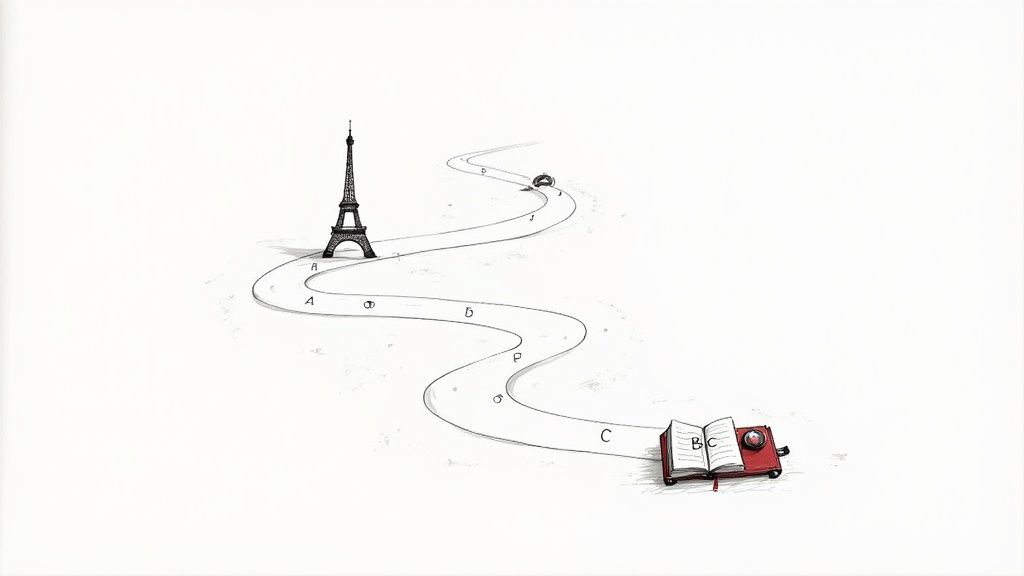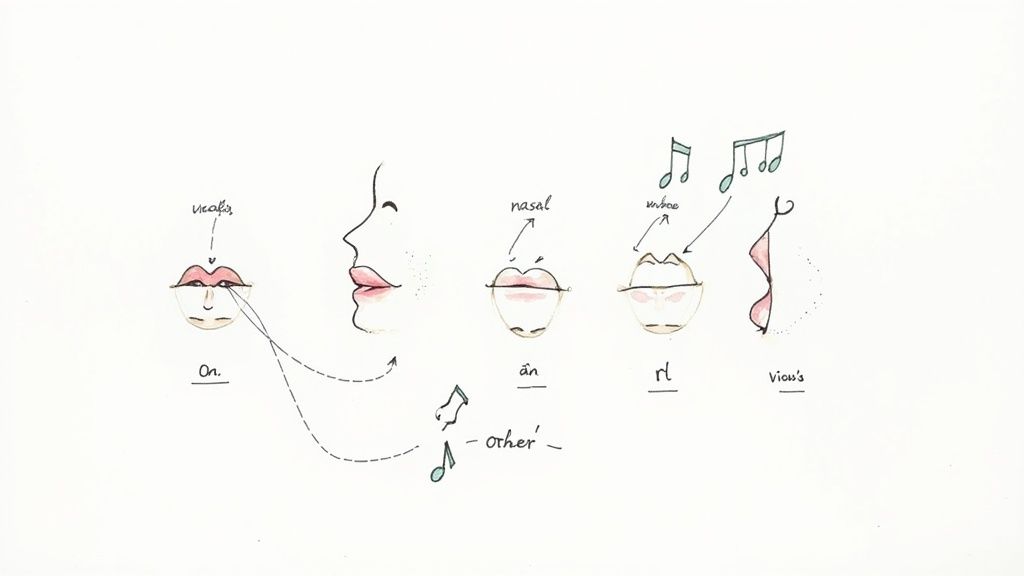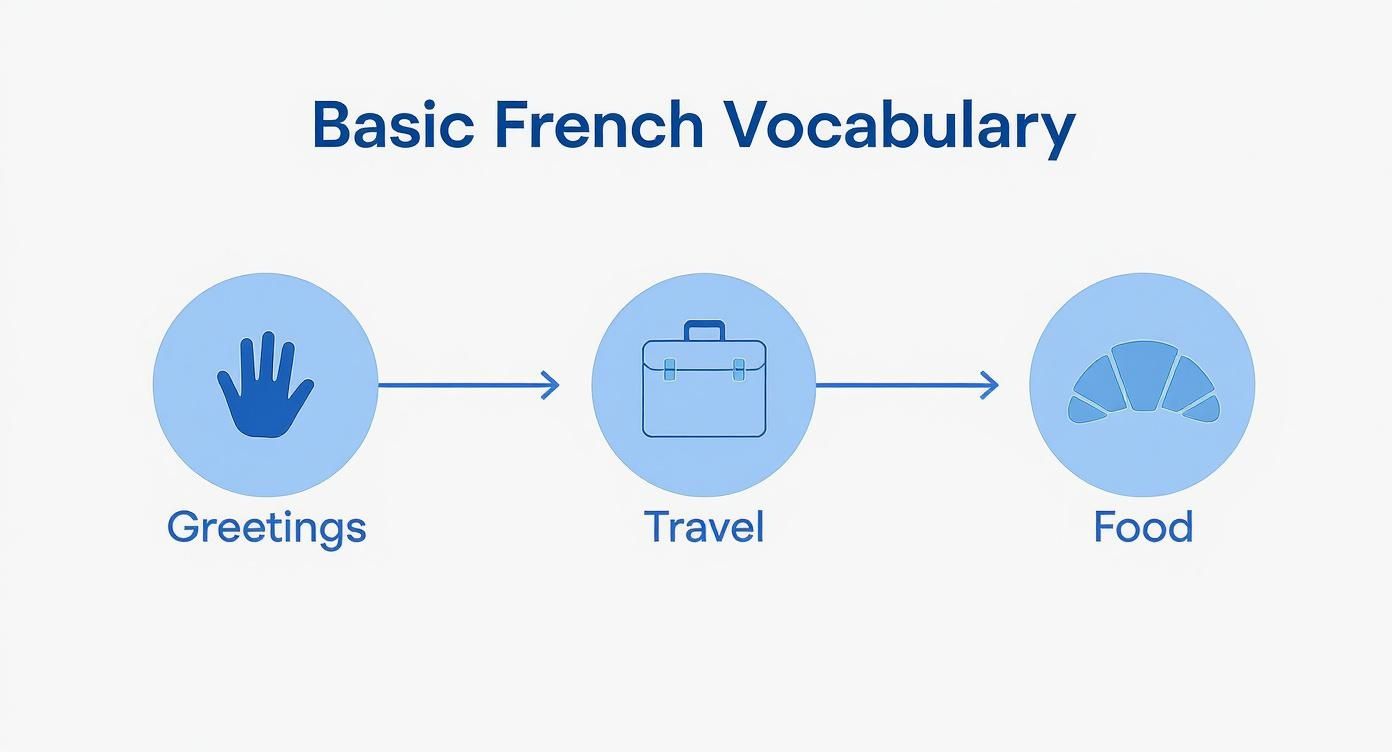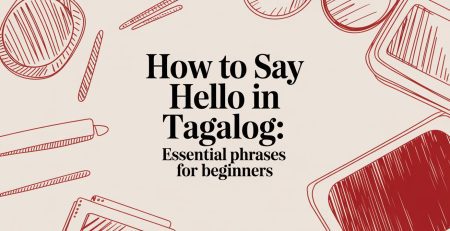Your Guide to Basic French Language
Welcome to your first foray into the beautiful world of French. Think of this guide as your personal roadmap to learning the basic French language. We’re here to make the process feel less like a chore and more like the exciting journey it truly is, covering everything from pronunciation and grammar to the essential vocabulary you'll need right away.
Your Adventure in the French Language Begins
Deciding to learn French is a fantastic move. It opens up whole new worlds of culture, connections, and even new ways of thinking. This guide is built to give you a practical toolkit for understanding how the language actually works, so you can start speaking with confidence from day one.
Instead of drowning you in a sea of complex rules, we'll build your knowledge step by step. Our focus is on the practical side of things, giving you the tools you need for real-world conversations and keeping you motivated along the way. Consider this your starting point, showing you exactly what to tackle first and where to go next.
Why Learn French in Singapore
While French isn't an official language here, its presence is definitely growing. A big reason for this is Singapore's significant French expatriate community. In recent years, around 13,000 French expatriates have called Singapore home—the highest concentration in any Asian country of its size.
You can read more about this vibrant community's influence on the Atelier An Phu website. This local context means you have unique opportunities for immersion right on your doorstep, and learning even a little French can unlock some fantastic new social and professional circles.
The key to success is transforming learning from a task into a passion. By focusing on practical communication and cultural discovery, you build a connection with the language that lasts a lifetime.
Our goal is to get you tangible results. By the time you finish this guide, you’ll be able to:
- Understand and pronounce the French alphabet and its unique sounds.
- Grasp fundamental grammar like gendered nouns and verb basics.
- Build a core vocabulary for everyday greetings and situations.
- Construct simple sentences to express yourself with confidence.
Whether you're learning for travel, your career, or just for the love of it, getting these fundamentals down is the most important step. If you're looking for more tips on structuring your learning, our guide on how to learn French on your own offers plenty of extra strategies and resources to support you.
Mastering the Sounds of French Pronunciation
Diving into the basic French language starts with getting a feel for its unique sounds. At first, French pronunciation can seem a bit intimidating. Its smooth, connected flow and sounds that simply don't have an English equivalent can feel like a real puzzle. But trust me, with a bit of practice, you’ll be speaking with clarity and confidence.
Let's use an analogy. English often sounds like we're hopping from one stepping stone to the next, with clear breaks between words. French is much more like a flowing river. Words glide into one another, creating that beautiful, melodic rhythm. This is thanks to a concept called liaison, and it's central to sounding genuinely French.
Decoding the French Alphabet and Vowels
The French alphabet might look identical to the English one, but don't be fooled—the sounds are often worlds apart. Vowels, in particular, are the heart of French pronunciation. They are much purer and more consistent than in English, where a single vowel can have half a dozen different sounds depending on the word.
One of the first hurdles for new learners is getting the hang of the famous nasal vowels. These are sounds made not in the mouth, but by letting air resonate through the nose.
- an / en: Imagine a doctor asking you to say "ahh," but instead of pushing the sound out of your mouth, you channel it through your nose. You'll hear this in words like maman (mum) and temps (time).
- on: This one is a bit like the sound in the English word "own," but again, the trick is to make it nasal. It’s the core sound in bon (good) and maison (house).
- in / ain: This sound is close to the "an" in "sang," but you make it with a wider smile while pushing the sound up through your nose. Think of words like vin (wine) and pain (bread).
The secret to mastering nasal vowels is to stop yourself just before your tongue touches the roof of your mouth to make an 'n' or 'm' sound. The vibration should hum in your nose, not close off in your mouth.
Tackling Tricky Consonants
Now for the consonants. A few of them consistently trip up English speakers, but the most notorious is the French 'r'. Forget the English 'r' that you form at the front of your mouth. The French 'r' comes from way back in your throat.
Try this: pretend you're gargling, but very gently. That slight, gravelly vibration is what you're aiming for. It’s the sound in words like rouge (red) and très (very). It definitely takes practice, but the best way to learn is to listen closely to native speakers and just mimic them relentlessly.
Another game-changing rule is that most final consonants are silent. This is a big one. In words like petit (small), grand (big), and trop (too much), you simply don't pronounce the final 't', 'd', or 'p'. Getting this right will instantly make you sound much more authentic.
Lastly, the letter 'h' is always silent in French. Always. Whether it's at the start of a word like hôtel or in the middle, you pronounce the word as if the 'h' doesn't even exist. This is a simple fix that gives you an easy win in your pronunciation journey.
To help you get started, here's a quick cheat sheet for some of the most common sounds you'll encounter.
Key French Pronunciation at a Glance
| French Letter/Combination | Approximate English Sound | French Example |
|---|---|---|
| ç | Like 's' in "sun" | garçon (boy) |
| ch | Like 'sh' in "shoe" | chat (cat) |
| é | Like 'ay' in "say" | été (summer) |
| è / ê | Like 'e' in "bed" | mère (mother) |
| j / g (before e, i, y) | Like 's' in "measure" or "vision" | je (I), manger (to eat) |
| u | No direct English equivalent. Form your lips for "oo" but say "ee" | tu (you) |
| ou | Like 'oo' in "food" | vous (you) |
| gn | Like 'ni' in "onion" | montagne (mountain) |
| oi | Like 'wa' in "water" | moi (me) |
Remember, this is just a starting point. The best way to improve is by listening and repeating, so don't be afraid to sound a little silly while you practise
Understanding French Grammar Fundamentals
Think of grammar as the scaffolding that holds a language together. It might seem like the most intimidating part of learning French, but getting a grip on the fundamentals is your ticket to building strong, coherent sentences. Let's break down the core concepts into much more manageable pieces.
One of the first hurdles for English speakers is the idea of gendered nouns. In French, every single noun has a gender—it's either masculine or feminine. This applies to everything from la table (the table, which is feminine) to le livre (the book, which is masculine).
Most of the time, there’s no real rhyme or reason for an object's gender. It’s just one of those things you get a feel for over time through practice and hearing the language used.
What makes this so important is that the small words that come before a noun, like 'the' or 'a' (we call these articles), have to match its gender. It’s a package deal.
- Masculine Nouns: Use le for 'the' (e.g., le stylo – the pen) and un for 'a' (e.g., un garçon – a boy).
- Feminine Nouns: Use la for 'the' (e.g., la chaise – the chair) and une for 'a' (e.g., une fille – a girl).
My best advice? Don't try to memorise endless lists of nouns and their genders. Instead, learn the noun and its article together as a single chunk. Think of it as learning the word le-livre, not just livre. This little habit makes the whole concept feel much more natural from day one.
Introducing Subject Pronouns and Core Verbs
Once you're comfortable with nouns, the next step is to add some action with verbs. And just like in English, French sentences need a subject to perform that action. These are the main players you'll be working with:
- je – I
- tu – you (the casual, friendly version)
- il / elle – he / she
- nous – we
- vous – you (the formal or plural version)
- ils / elles – they (for a masculine/mixed group or an all-female group)
These pronouns are your launchpad for using the two most critical verbs in the entire French language: être (to be) and avoir (to have). Changing a verb to match its subject is called conjugation. Think of it like having the right key for a specific lock; each subject pronoun needs its own unique verb form to unlock the meaning.
Getting être and avoir down is non-negotiable if you're serious about learning French. They're not just used on their own; they also act as "helper" verbs to form past tenses, making them absolutely essential for pretty much any conversation.
Here’s a quick look at how they change in the present tense:
| Subject Pronoun | Être (to be) | Avoir (to have) |
|---|---|---|
| je (I) | suis (am) | ai (have) |
| tu (you) | es (are) | as (have) |
| il/elle (he/she) | est (is) | a (has) |
| nous (we) | sommes (are) | avons (have) |
| vous (you) | êtes (are) | avez (have) |
| ils/elles (they) | sont (are) | ont (have) |
With just these building blocks, you can already put together simple, perfectly correct sentences. For instance, Je suis étudiant (I am a student) or Elle a un chat (She has a cat). This simple structure is the very heart of how French sentences work.
While French isn't an official language in Singapore, its growing popularity in international schools and among adult learners beautifully complements the nation's diverse linguistic fabric. With English used by 48.3% of the population at home, learning French opens up a connection to the global Francophone community. You can discover more insights about Singapore's languages and see how they all fit together.
Building Your Essential French Vocabulary
Think of vocabulary as the bricks you'll use to build your French-speaking abilities. Without them, you can't construct a single sentence. To really get a handle on the basic French language, the trick isn't to memorise endless, random lists of words. It's much smarter to focus on vocabulary that's grouped into themes you'll actually encounter in the real world.
It's a bit like stocking a new kitchen. You wouldn't start with exotic, rarely-used spices. You’d grab the essentials first: salt, pepper, oil. We're going to do the same thing with French, focusing on the words you'll use from day one. This way, you can jump into simple conversations almost immediately, which is a fantastic confidence booster and makes the whole process feel worthwhile.
Greetings and Everyday Politeness
First impressions matter, and in French, your entry ticket to any conversation is a proper greeting. These aren't just throwaway words; they're vital social cues that signal respect and friendliness. Nailing the right phrase for the right moment can completely change how people respond to you.
One of the first, and most crucial, distinctions you'll need to grasp is the difference between tu and vous.
- Tu: This is your informal "you". You’ll use it with friends, family members, kids, and anyone you know on a casual basis. It’s a sign of familiarity and closeness.
- Vous: This is the formal "you". It’s your default for strangers, older people, in professional settings, or any time you’re talking to a group. Using vous is a clear sign of politeness and respect.
When in doubt, always, always start with vous. It's much better to be a little too formal than accidentally too familiar. If the other person is comfortable switching to a more casual tone, they’ll often let you know you can use tu.
To get you started, here's a quick cheat sheet of some of the most common and useful French phrases. Learning these will give you a solid foundation for your first interactions.
Essential French Greetings and Phrases
| French Phrase | English Translation | When to Use |
|---|---|---|
| Bonjour | Hello / Good morning | Your go-to greeting for most of the day, right up until the late afternoon. |
| Bonsoir | Good evening | Once evening hits, switch from bonjour to this. |
| Au revoir | Goodbye | The standard, polite way to say goodbye in almost any situation. |
| S'il vous plaît | Please (formal) | Use this when asking for something from anyone you’d address with vous. |
| S'il te plaît | Please (informal) | The casual version of "please," for people you'd address with tu. |
| Merci (beaucoup) | Thank you (very much) | A universal phrase for showing gratitude. |
| Excusez-moi | Excuse me | Perfect for getting someone's attention, or apologising if you bump into them. |
| Je ne comprends pas | I don't understand | A lifesaver for any beginner. Don't be afraid to use it! |
Think of these phrases as your survival kit. With just these few expressions, you can navigate a surprising number of simple social situations politely and effectively.
Navigating Travel and Daily Life
Once you've got greetings down, the next practical step is to learn words that help you get around. It might sound daunting, but studies have shown that knowing just 100 core words can be enough to manage most essential travel situations, from ordering a meal to asking for directions. These are the words that give you a sense of independence and make you feel much more comfortable.
Picture yourself at a café in Paris. What do you need to say? You'll want to order a coffee, ask for the bill, and maybe find the restroom. Simple, right?
Here are a few high-impact terms focused on exactly that kind of scenario:
- Un café: A coffee
- L'addition: The bill
- La gare: The train station
- Où sont les toilettes? Where are the toilets?
- Combien ça coûte? How much does it cost?
Learning words in these small, thematic groups is a far more powerful strategy than just memorising random lists. You’re not just learning words; you’re building a mental map of situations and the language that goes with them. This makes the vocabulary much easier to remember and actually use when you need it.
Constructing Your First French Sentences
This is where the magic happens. You’ve got the sounds, you’ve wrestled with some grammar, and you’ve started stockpiling essential words. Now, let’s put all those pieces together and actually build something: your very first sentences in French.
Think of it like playing with LEGO. You’ve got your individual bricks—the pronouns, verbs, and nouns. It’s time to learn how to click them together into a meaningful structure. We'll start with the most basic blueprint of all.
From Words to Simple Statements
The simplest French sentence follows a pattern that should feel very familiar: Subject + Verb + Object. You already know the key players here. For subjects, you have pronouns like je (I), tu (you), and elle (she). For verbs, you have the workhorses être (to be) and avoir (to have).
Let’s build one right now. Take the subject je, the verb suis (am), and a noun like étudiant (student).
- Je suis étudiant. (I am a student.)
See? It’s that straightforward. Let's try it with avoir. Combine elle (she), a (has), and un chat (a cat).
- Elle a un chat. (She has a cat.)
Congratulations, you're officially forming complete, correct sentences in French. The trick is to see these as simple formulas you can plug new vocabulary into as you learn it.
Turning Statements into Negatives
Saying what something isn't is just as crucial. In French, you do this with a neat little two-part construction: ne…pas. The easiest way to remember this is to picture it as a sandwich, with your verb as the filling. You just pop ne before the verb and pas right after it.
Let's go back to our first sentence, Je suis étudiant. To make it negative, we simply wrap the verb suis in our ne…pas sandwich.
Je ne suis pas étudiant. (I am not a student.)
This structure is beautifully consistent for simple tenses. It’s a reliable rule you can apply again and again—a true cornerstone of basic French that you'll use constantly.
The infographic below shows how different vocabulary themes, from greetings to travel, give you the specific building blocks for these sentences.
As you can see, mastering words in key areas gives you the exact material you need to build practical sentences for real life.
Asking Your First Questions
So, how do you ask a question? There are a few ways, but one of the easiest for beginners is to just raise the pitch of your voice at the end of a statement. It works exactly like it does in English.
- Statement: Tu es étudiant. (You are a student.)
- Question: Tu es étudiant? (Are you a student?)
Another incredibly common method is to stick the phrase Est-ce que (pronounced ess-kuh) at the start of a sentence. Think of it as a universal "question flag" that instantly turns a statement into a question.
- Est-ce que tu es étudiant? (Are you a student?)
As you start putting your first sentences together, remember that building your speaking skills goes hand-in-hand with reading. Working on general strategies for developing reading comprehension will make you more comfortable with sentence patterns. And for real-world practice, nothing beats trying these skills out during a language exchange in Singapore, where you can chat with native speakers.
Common Questions About Learning French
Starting any new language journey always brings up a bunch of questions. Diving into the basic French language is no different, but having a clear map can help you set good expectations and keep your spirits up when things get tricky. Let's tackle some of the most common things beginners ask.
One of the first questions on everyone's mind is, "How long until I can actually have a conversation?" While everyone learns at their own speed, if you put in a consistent 3-5 hours per week, you can expect to reach a solid basic level in about three to six months. That’s enough to handle introductions, ask for directions, and order that croissant like you know what you’re doing.
What Is the Hardest Part for Beginners?
For most native English speakers, the two biggest hurdles right out of the gate are pronunciation and grammar. It takes a little while to get your mouth around new sounds, like the famous nasal vowels or that throaty French 'r'. And then there's the whole idea of nouns having a gender—why is a table feminine? Don't worry, the goal at the start is just to be understood, not to sound like a Parisian news anchor.
Verb conjugations can also feel like a mountain to climb. English verbs are pretty straightforward, but in French, they change their endings for almost every subject. It can feel like a lot to memorise.
The secret is to look for the patterns instead of getting bogged down in endless charts. The more you listen and read, the more these patterns will just start to feel right, without you having to think so hard about the rules.
This way, grammar becomes less of a chore and more of an intuitive skill you build over time.
What Are the Best Free Resources to Use?
The good news? You don't need to break the bank to get started. There's a fantastic amount of high-quality, free stuff online to help you along.
- Language Apps: Tools like Duolingo turn learning into a game, which is great for picking up vocabulary and simple sentences in a fun, low-pressure way.
- YouTube Channels: You can find thousands of videos from native French speakers teaching everything from grammar and pronunciation to cultural quirks and everyday slang. It's like having a free tutor on demand.
- Language Exchange: Apps like Tandem are brilliant. They connect you with native French speakers who want to learn English, so you can practise for free through text or voice chat. It’s the perfect way to get real-world experience.
For those moments when you need to understand something right away, looking into tools like real-time translation solutions can be a massive help. And if you're in Singapore and prefer a more structured approach, finding the right language school in Singapore can give you the expert guidance and community you need to really speed things up.
At Spanish Council Singapore, we believe learning a language should be an adventure. While Spanish is our speciality, we're here to cheer on anyone taking the plunge into a new language.















